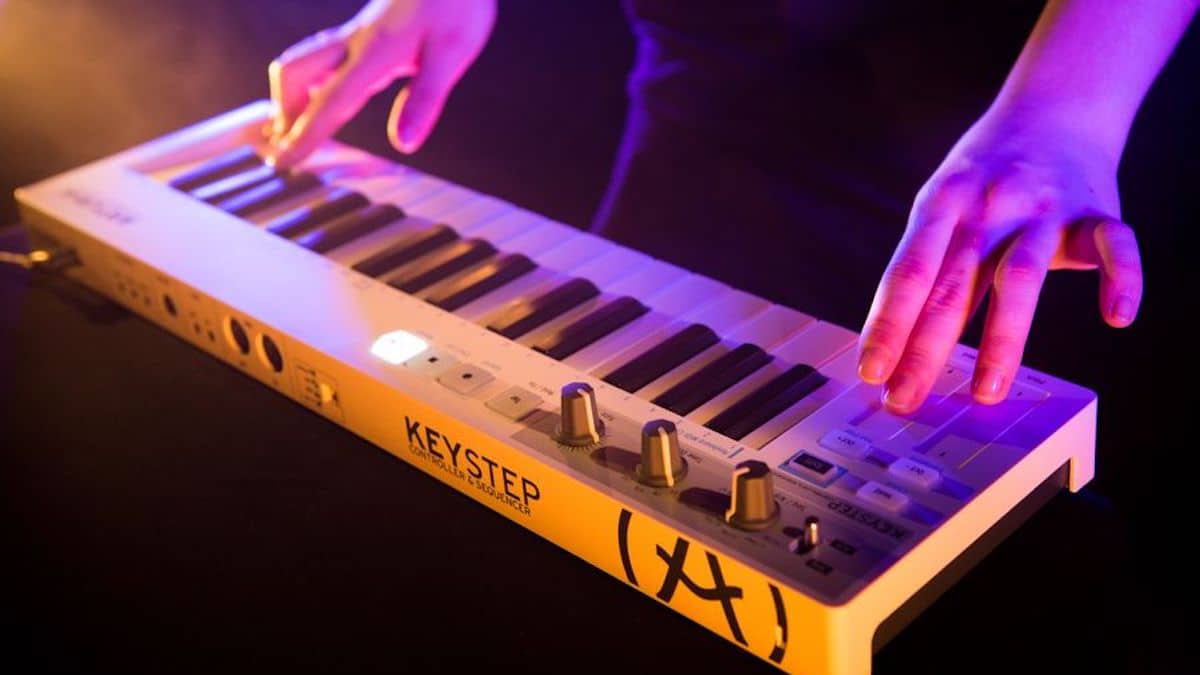In This Issue
The Compact Studio: Maximum Sounds, Minimum Space

Synth and Software contributor Mark Jenkins provides valuable advice for musicians working in a very restricted space.
Although huge studio setups are still common, increasingly musicians need to work in very restricted space. Happily many manufacturers are creating compact, powerful instruments for them to use.
If the center of your setup is a laptop running Logic, Cubase, Fruity Loops, Ableton Live or a similar DAW, integrating small hardware instruments is straightforward and can add a much more tactile element to composition and performance.
Synth and Software has already looked at the Craftsynth 2 from Modal.

This is a palm-sized monophonic digital synth that can run on batteries, and that can offer convincing analog sounds. Arpeggio patterns are also possible, and the instrument has built-in effects. So this is a great way to start compositions with a strong bassline, or a quirky melody part or effects sounds.
One alternative is the Uno from IK Multimedia.

The company specializes in software, but does have several hardware products mostly in the area of interfacing, and Uno is the company’s first hardware synth.
This desktop device features just over two octaves of pad-style mini keys and a single, genuine analog monophonic voice. It has an arpeggiator and a step sequencer, 100 memories, and controllers for filter cutoff and resonance, among other parameters.
Uno is not as sonically versatile as Craft but what it specializes in – twangy resonant analog bass and lead sounds, precise arpeggios and sequencer patterns – it does really well. There’s now an accompanying and equally compact Uno drum machine.
If you find monophonic performance too restricting, then Modal now offers Skulpt.

The voice architecture is similar to Craft’s, but the addition of polyphony adds lots of possibilities. Write flowing string parts, heavy digital-sounding brassy stabs, melodic harmonies, or sweeping wavetable-like cascades – the sounds available have been compared to music by Deadmau5, Jexus and others, and can come (close enough to) those from a MiniMoog, a Prophet 5 or a PPG Wave 2. You’re not by any means limited to static analog-like waveshapes – the wavetable is continuous from one waveform to another so there’s a huge variation of sound textures available.
Skulpt, like Craft, has a built-in keyboard, but to make the most of the instrument you may want to add an external keyboard controller, maybe with a more flexible arpeggiator or sequencer.
Arturia launched Beatstep and Beatstep Pro – single track and multitrack hardware sequencers with key pads – before introducing Keystep…

Now there are several compact keyboard sizes from Arturia, the MicroLab 25 (around $60), the very portable two and a half octave Keystep (around $90), the 3-octave Keystep 37 (around 120 dollars), and the full size keys Keystep Pro.
These controllers all look lightweight from a distance, but are in fact strongly and heavily built, well suited to being moved around and used in various locations. So a typical setup with an Arturia keyboard, a couple of these compact hardware instruments, and a laptop can very easily fit (along with some compact powered speakers, or a good quality headphone like my favourite Ear Pollution Ronin) onto a typical work desk.
If you have a spot more space, or if you create a little shelf or riser to make more horizontal surface available – IKEA has some options in these areas – another consideration could be one of the Behringer desktop modules.
Behringer’s original and clone synths have become massively popular, and while the PolyD, MonoPoly, MS-1 (from the Roland SH101) and Deepmind all have keyboards (though there’s a Deepmind desktop module too) there’s a huge choice of compact wedge-shaped non-keyboard modules – the Cat, K2 (from the Korg MS20 design), Pro-1, and Model D (from the MiniMoog), the originals of which all had full keyboards, the TD-3 (from the Roland TB303 Bassline) and the original design semi-modular Neutron or Crave for example.
Behringer’s clone of the ARP2600, though, fits in a 19-inch rack, and with a little more desk space you could indeed accommodate a short shallow rack, or a Eurorack module cabinet such as those from Behringer, Arturia, TipTop, MakeNoise, or the Cre8 NiftyCASE.
But here we’re starting to get into GAS (gear acquisition syndrome) territory, and in significant danger of our compact studio setup starting to overflow.
Alisú CL is a musician and graphic designer based in Valparaiso in Chile, and her compact studio is a great example. On a single desk she has synths and controller keyboards from Arturia, effects units, drum machines and more – though she does make separate space for a larger format mixer. Alisú creates a fascinating combination of improvised, rhythmic dance and abstract sounds. Check out – www.soundcloud.com/alisu
Whatever your compact studio setup (and whether you leave desk space for speakers, or mount them on the wall) there’s no reason why you shouldn’t get a huge sound from these relatively tiny instruments. So all you need to do is think big, but stay compact.
Synth and Software contributor: Mark Jenkins – www.markjenkinsmusic.com
Alisú CL profile extracted from the forthcoming book “Synthesizers: The Ultimate User’s Guide”
More Synth and Software Reviews



















